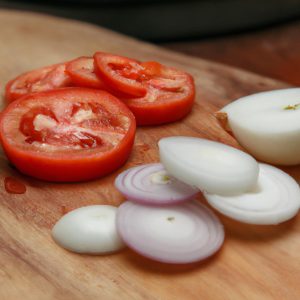As we strive to maintain a healthy lifestyle, it’s vital to understand the nutritional value of the foods we consume. One such food is the red onion, a staple in many dishes worldwide. But do you know how many calories are in a red onion?
In this comprehensive guide, we’ll explore the calorie content of red onions and why it’s essential to know this information. We’ll also delve into the nutritional benefits of red onions and how to incorporate them into your diet. So, whether you’re a foodie or a health enthusiast, this guide is for you.
But first, let’s start with the basics. What exactly is a red onion? A red onion is a type of onion with a reddish-purple skin and white flesh. It’s slightly milder in taste than yellow onions and is often used raw in salads, sandwiches, and salsas.
Now that we know what a red onion is, let’s discuss why it’s important to know its calorie content. Counting calories is a way to monitor your food intake and maintain a healthy weight. By understanding the calorie content of red onions, you can better manage your daily calorie intake, leading to a healthier lifestyle.
In the next sections, we’ll dive deeper into the nutritional value of red onions and how many calories they contain. So, let’s get started!
Nutritional Value of Red Onion

Red onions are not only low in calories but also packed with essential nutrients. Let’s take a closer look at the macronutrients and micronutrients that make up a red onion’s nutritional value.
Macronutrients
Red onions are primarily made up of carbohydrates, with each medium-sized onion containing approximately 11 grams of carbohydrates. They also contain a small amount of protein, less than 1 gram per onion, and almost no fat.
Micronutrients
Red onions are a rich source of essential vitamins and minerals, including vitamin C, vitamin B6, folate, and potassium. One medium-sized red onion contains approximately 14% of the daily recommended intake of vitamin C, which plays a critical role in the immune system. Additionally, red onions contain quercetin, a flavonoid with antioxidant properties that may help prevent chronic diseases.
Comparison with Other Vegetables
Compared to other vegetables, red onions have a higher concentration of antioxidants and flavonoids. They’re also relatively low in calories, making them a great option for those watching their weight. In comparison to white onions, red onions have a higher concentration of antioxidants and flavonoids, making them a healthier choice.
In the next section, we’ll explore how many calories a red onion contains, so keep reading!
How Many Calories in Red Onion

When it comes to counting calories, it’s crucial to understand how they are measured. Calories are a measure of the energy in food and are typically measured in units of kilocalories (kcal). One kcal is equivalent to 1,000 calories, which is why you’ll often see calorie counts listed in kcal on food labels.
So, how many calories are in a red onion? On average, one serving of red onion, which is approximately 1/2 cup or 80 grams, contains around 28 kcal. This serving size also contains 1 gram of protein, 6 grams of carbohydrates, and 0.1 grams of fat.
It’s important to note that several factors can affect the calorie count of red onions. For example, the growing conditions, storage methods, and preparation techniques can all impact the final calorie count. Additionally, the calorie count can vary slightly between different varieties of red onions.
Overall, red onions are a low-calorie food, making them an excellent addition to a healthy diet. In the next section, we’ll explore the health benefits of red onions, which go far beyond their calorie content.
Health Benefits of Red Onion

Red onions aren’t just flavorful and versatile, but they also offer a host of health benefits. Let’s take a closer look at some of the health benefits of red onions.
Antioxidant Properties
Red onions are rich in antioxidants, such as flavonoids and anthocyanins. These antioxidants help protect our bodies from harmful free radicals that can cause damage to cells and lead to diseases such as cancer, heart disease, and Alzheimer’s disease. The antioxidants in red onions also help reduce inflammation in the body, which can improve overall health.
Anti-inflammatory Effects
Inflammation is a natural response of the body to injury or infection. However, chronic inflammation can lead to various health problems such as arthritis, heart disease, and cancer. Red onions contain compounds that have anti-inflammatory properties, such as quercetin and sulfur compounds. These compounds help reduce inflammation in the body, promoting good health.
Regulation of Blood Sugar Levels
Red onions contain a type of fiber called inulin, which can help regulate blood sugar levels. Inulin slows down the absorption of sugar in the bloodstream, preventing spikes and crashes in blood sugar levels. This can be particularly beneficial for individuals with diabetes or those at risk of developing the disease.
Prevention of Certain Diseases
Red onions contain sulfur compounds that have been linked to the prevention of certain diseases, such as cancer and heart disease. The sulfur compounds in red onions promote the production of glutathione, a powerful antioxidant that helps protect the body from various diseases.
Incorporating red onions into your diet is an easy way to reap these health benefits. So, don’t hesitate to add some red onions to your next meal.
Incorporating Red Onion into Your Diet
Red onions are a versatile ingredient that can add flavor, texture, and color to a wide variety of dishes. Here are some recipe ideas to help you incorporate red onions into your diet:
Recipe ideas for red onion
- Red Onion and Goat Cheese Tart
- This savory tart combines red onions and tangy goat cheese for a delicious appetizer or light meal.
- Red Onion and Tomato Salad
- A simple yet flavorful salad that pairs red onions with juicy tomatoes and a tangy vinaigrette.
- Grilled Red Onion Skewers
- Marinated red onions grilled to perfection make a tasty side dish or addition to any barbecue.
Meal planning tips
When planning your meals, consider adding red onions to dishes that could use some extra flavor and nutrition. For example:
- Add red onions to omelets or frittatas for a protein-packed breakfast.
- Use red onions as a topping for burgers or sandwiches instead of traditional lettuce and tomato.
- Roast red onions with other vegetables for a healthy and flavorful side dish.
Considerations for individuals with dietary restrictions
Red onions are generally safe for most people to eat. However, individuals with certain dietary restrictions may need to take precautions. For example:
- Those with irritable bowel syndrome (IBS) may need to limit their intake of onions as they can trigger digestive symptoms.
- Individuals following a low FODMAP diet should be cautious with red onions as they are high in fructans, a type of carbohydrate that can cause digestive issues in some people.
By following these tips, you can easily incorporate red onions into your diet and enjoy their many health benefits. Remember to always consult with a healthcare professional if you have any questions about your diet and nutrition.
Conclusion
In conclusion, knowing the calorie content of red onions is crucial in maintaining a healthy lifestyle. As we’ve learned, red onions are low in calories but high in essential nutrients such as fiber, vitamin C, and potassium.
Incorporating red onions into your diet is easy and versatile, whether you enjoy them raw in salads or cooked in your favorite dishes. With so many health benefits, there’s no reason not to add red onions to your meals regularly.
At onionfacts.com, we’re committed to providing you with accurate and informative articles to help you make informed decisions about your health. We hope this comprehensive guide has shed some light on the calorie content and nutritional value of red onions.
So, the next time you’re at the grocery store, be sure to pick up a few red onions and get creative in the kitchen. Your taste buds and your body will thank you!







